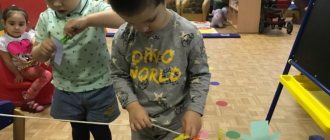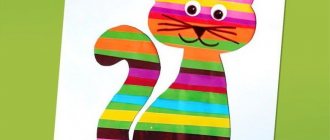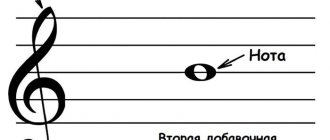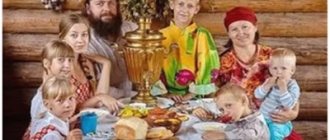Didactic games
The games below will not only encourage the timid and cheer up the crying one, but will also calm the overly naughty child, redirect attention and help relax the angry, aggressive child.
Playing with a dog
Material. Toy dog.
Progress of the game. The teacher holds the dog in his hands and says:
Bow-wow! Who's there? This is a dog visiting us. I put the dog on the floor. Give Petya a paw, little dog! Then he approaches the child, whose name is named, with the dog and offers to take it by the paw and feed it. They bring a bowl of imaginary food, the dog “eats soup,” “barks,” and says “thank you!” to the child.
When repeating the game, the teacher calls the name of another child.
Collecting "treasures"
Material. Basket.
Progress of the game. During a walk, the teacher collects “treasures” (pebbles, pods, twigs, leaves, shells) with the child and puts them in a basket. Finds out which “treasures” arouse the greatest interest in the baby (this will suggest further ways of communication). Then he names some “treasure” and asks to take it out of the basket.
Making a collage
Material. Scraps of colored paper, greeting cards, string, pieces of foam, yarn, etc.
Progress of the game. The teacher spreads a large sheet of thick paper or cardboard on the table. Using a brush, coat a piece of foam plastic (postcard, etc.) with glue on one side and hand it to the child to stick it on the paper. Allows the child to choose the items he would like to stick on. After carefully observing the actions of an adult, the child will be able to apply the glue himself. The completed collage can be hung in a prominent place for everyone to admire.
(The game helps develop creative skills.)
Caught a fish
Material. Cardboard box, metal bottle caps (“fish”), magnet, stick and rope (for a fishing rod).
Progress of the game. Several metal bottle caps, preferably of different colors, are placed in a cardboard box. A stick is tied to one end of the rope (or ribbon), and a magnet bar is tied to the other. The teacher shows the child how to fish “fish” out of the box by attracting metal plugs with a magnet. If the corks are different colors, then the baby can be asked to pull out, for example, a red fish.
After all the plugs have been removed, the adult counts them (“That’s how many fish we caught!”), and the game starts over.
(The game helps develop coordination of movements.)
Let's ride a horse
Material. Rocking horse (if there is no horse, you can sit the child on your lap).
Progress of the game. The teacher puts the child on a rocking horse and says: “Masha is riding a horse, (says in a quiet voice) no-no.” The child repeats quietly: “No-no.” Adult: “To make the horse run faster, tell it loudly: “No-no, run, little horse!” (Swings the child more strongly.) The child repeats the phrase together with the teacher, then independently. The adult ensures that the child pronounces the sound “n” drawn out, and the entire sound combination loudly and clearly.
(The game develops speech activity).
Blow into or onto something
Progress of the game. The teacher blows on a small balloon through a straw, causing it to move around the room. Blows on all fingers, then on each one separately. Blows a leaf from the child's palm. Blows on a flower or blade of grass. The child repeats the actions of the adult.
Blow on the balloon, blow on the pinwheel, blow on the horn
Material. Balloon, pinwheel, horn.
Progress of the game. A balloon is suspended at the level of the child’s face, and a pinwheel and a horn are placed on the table in front of him. The teacher shows how to blow on a balloon so that it flies high, and invites the child to repeat the action. Then the adult blows on the turntable to make it spin, blows the horn, and the child repeats.
(The game promotes the development of the speech apparatus).
Book - guess what?
Material. Notebook with spiral wire.
Progress of the game. Paste pictures of objects known to the child across the page (on the right side) in the notebook. Each page without pictures is cut into several horizontal strips, starting from the left edge. Looking at the book with the baby, the teacher gradually turns away strip after strip. The child tries to guess what is shown in the picture.
(The game develops imagination and logical thinking).
Fun with a magnifying glass
Material. Magnifying glass (preferably plastic).
Progress of the game. During a walk, the teacher gives the child a blade of grass. Shows how to look at it through a magnifying glass. Invites the child to look through a magnifying glass at fingers and nails - this usually fascinates the baby. While walking around the site, you can examine a flower or the bark of a tree, examine a piece of earth: are there any insects there, etc.
(The game develops observation skills).
Walking along the outlines of different figures
Material. Wide dense tape (braid).
Progress of the game. Using tape, circles, squares, triangles, etc. are depicted on the floor. The teacher shows the child how to walk along the tape (start with a circle). An adult takes the baby by the hand, walks with him and sings to any tune: “We are walking in a circle, tra-la-la, tra-la-la. We go in a circle, tra-la-la, tra-la-la." This is how all the figures pass. Then the teacher tries to walk along them with the child, walking backwards, sideways, on tiptoes, jumping over the figure, etc.
(The game contributes to the development of ideas about objects).
Together with the bear
Material. Toy bear.
Progress of the game. The teacher talks “as equals” with the bear and the child, for example: “Katya, do you like drinking from a cup?”, “Misha, I like it. Knocks fist on fist, claps his hands. Alternating such actions, the teacher creates a certain sequence of sounds, for example: knock-clap, knock-knock-clap, knock-clap-clap, etc.






